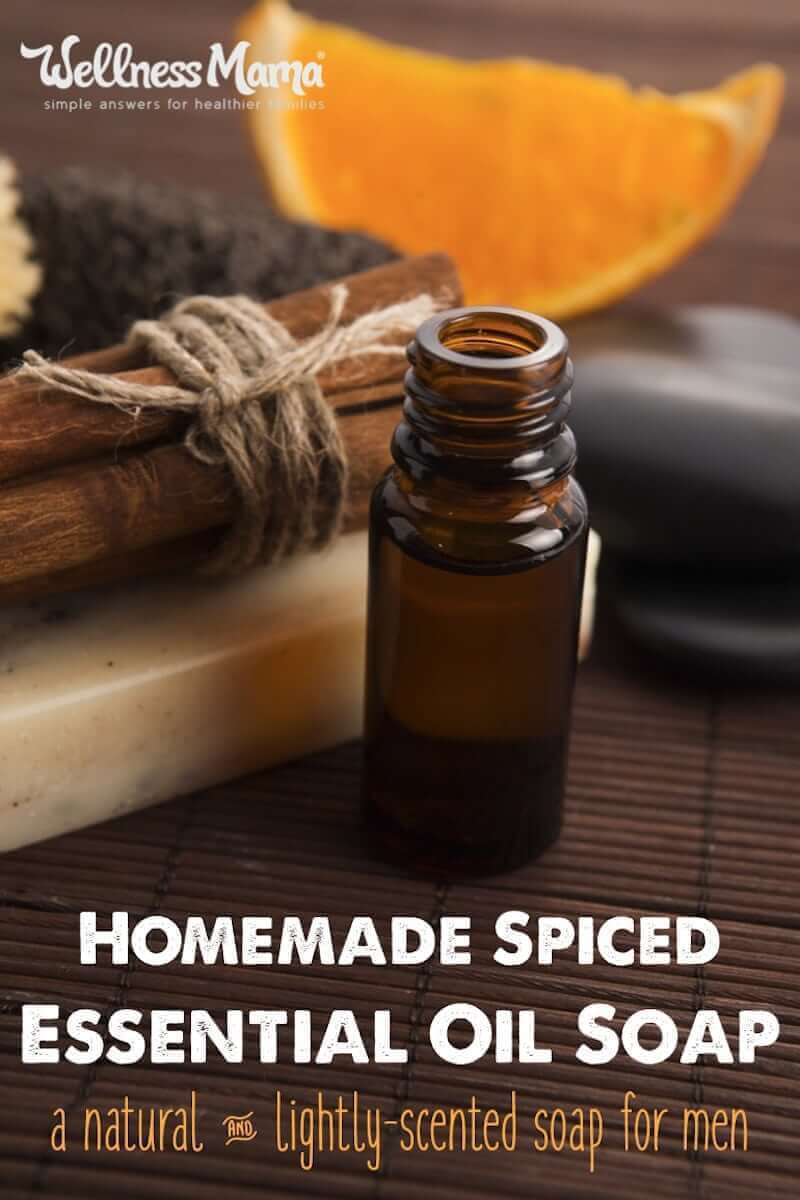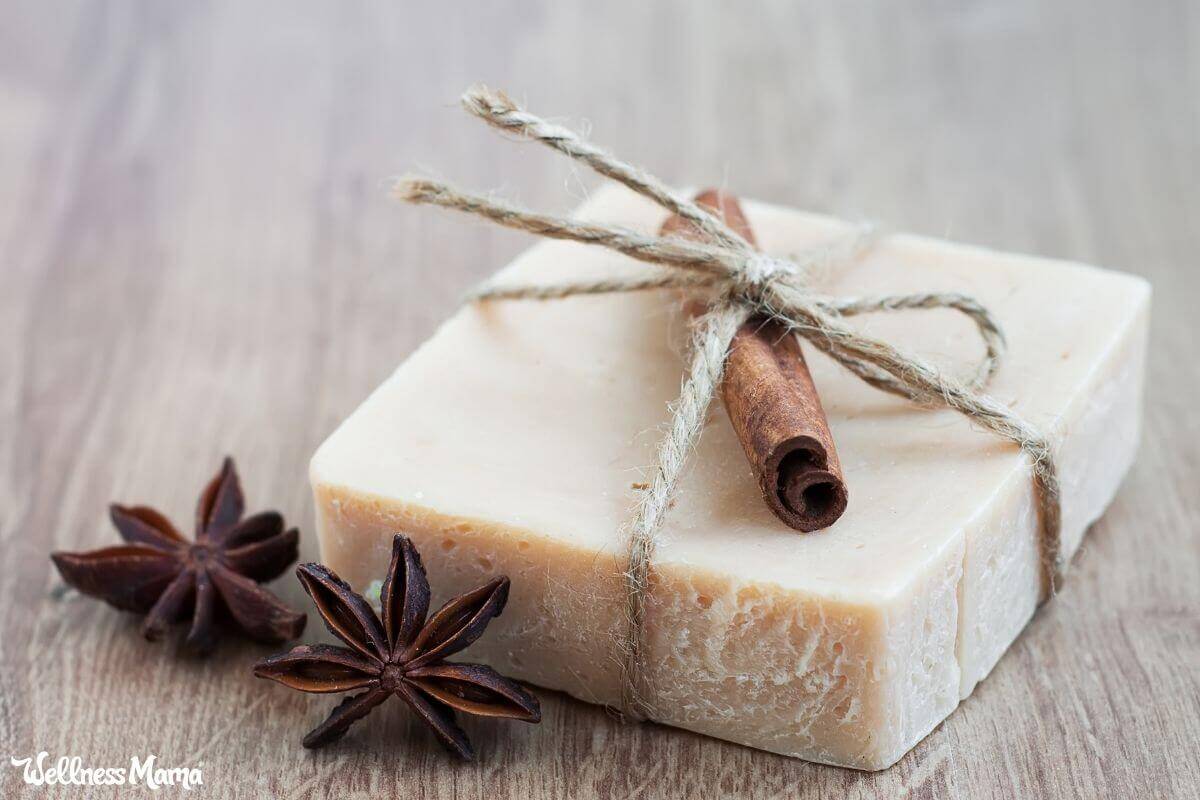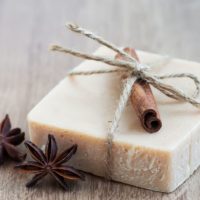I love using homemade soap. I love it even more because I can make it myself. Soap-making can be quite addicting! There are countless recipes and options allowing you to completely customize your soap to fit your needs and desires.
My husband, however, was not exactly thrilled about using my girly scented soap, so I set out to make some manly smelling soap just for him. He loved the result and has been using my homemade soap ever since.
This is a cold process recipe, however, if you prefer to make your soap using a hot-process method, this recipe should work well for that too.
Working With Lye
Lye is a necessary part of the soap-making equation. Soap is the result of a chemical reaction between lye (that has been activated by water) and an oil or animal fat. This reaction is called saponification. You cannot make soap from scratch without lye but with a properly calculated recipe, no lye will remain in your final product.
It can be intimidating to work with lye for the first time and it is definitely necessary to follow safety precautions, but don’t let that stop you from making your own soap!
Safety: When I work with lye there are a few things I do to ensure I am using it safely. These are the precautions I always take:
- Wait until children are in bed. Children or animals underfoot can cause distractions or spills and working with lye is a task that should be done when they are not around.
- Wear protective eyewear and rubber gloves as well as long sleeves.
- Have a clean workspace so that nothing is ruined in case of a spill.
- Mix lye in a very well ventilated area. I personally do it in my backyard so that I don’t have to worry about the fumes in the house and then if I were to spill it would be outside.
- Always add lye to the water. DO NOT add water to lye. This will cause a caustic eruption. Many veteran soapers use the expression “snow floats on the lake” as a reminder for the order they should be mixed.
Soap Making Ingredients
As I mentioned before, there are countless possibilities when you create your recipe. For this soap I wanted a hard yet moisturizing soap with a lot of lather for my husband so I used the following ingredients.
Tallow – makes a hard bar with high cleansing abilities. It is a great basic ingredient for soap. Most commercial soaps are made primarily with tallow. It is easy to render your own. If you want a pure vegetable soap you can substitute palm oil (sourced sustainably) but make sure you recalculate how much lye you will need before you begin.
Olive oil – this is another classic soap ingredient. It initially makes a softer bar but with age can become quite hard. It is very moisturizing but does not have the best lather.
Coconut oil – gives a wonderful, fluffy lather but can be drying so it is best kept to no more than 30% of your soaping oils.
Castor oil – I almost always include castor oil in recipes that contain coconut oil because it helps stabilize the lather made by the coconut oil. Use no more than 10% to avoid creating a lather that feels a bit slippery.
Beeswax – adds to the hardness of the bar.
Essential Oils – your choice for desired scent.
I used orange, patchouli, cinnamon, and clove essential oils to create a manly spiced scent. Patchouli helps to anchor other scents so that they last longer. I only used a very small amount of the cinnamon and clove because these oils are potent and can speed up trace, which can make it difficult to get the soap batter into the mold.
Soap-Making Supplies
I have a set of supplies I keep on hand for making soap. You can use your kitchen tools if you are diligent about cleaning them thoroughly but I prefer to keep them separate.
- Glass jar or high quality plastic pitcher for mixing lye and water
- Second glass jar or disposable plastic cup for measuring lye
- Non-reactive pot or slow-cooker for warming oils
- Small glass bowl for measuring essential oils
- Digital infrared thermometer or 2 candy thermometers (one for lye and one for oils)
- Soap mold
- Immersion blender
- Digital scale
- Spoon for mixing lye
- Spatula
- Protective gloves and eyewear
- Vinegar for final clean-up
Spiced Soap for Men Recipe
Materials
- 10.9 oz distilled water
- 4.39 oz lye
- 13 oz tallow
- 12 oz olive oil
- 4.5 oz coconut oil
- 2 oz castor oil
- 1.5 oz beeswax pellets
- 1.5 oz orange essential oil
- .4 oz patchouli essential oil
- 22 drops cinnamon essential oil
- 15 drops clove essential oil
Instructions
- Prepare your mold: If you are using a wood mold it will need to be lined with wax paper. Silicone molds are ready without any special preparation. You can also use any box if you line it with wax paper or a thick garbage bag.
- Wearing protective gear, place the glass jar on the scale, and tare the scale.
- Pour distilled water into the jar until it reads 10.9 oz.
- Set aside.
- Put the second jar on the scale and tare the scale. Wearing protective gear, carefully pour the lye into the jar until the scale reads 4.39 oz.
- Take both jars and a spoon outside.
- Still wearing protective gear, slowly pour the lye into the water.
- Stir the mixture. It will become quite hot so keep this in mind if you need to move it.
- Let the water/lye mixture sit and cool until it reaches about 100°F.
- While the lye is cooling, measure all other ingredients EXCEPT the essential oils and warm them together in a pot or slow-cooker. The beeswax will take the longest to melt.
- Once everything is melted, remove the pan from the heat and let it cool to 100°F. I use the infrared thermometer about every 5-10 minutes to test the temperature, which works really well. A candy thermometer placed in each container also works. If one is cooling faster than the other you can put your oils back on the heat source or the water/lye mixture in a warm water bath to slow the cooling process a bit. Ideally, you want the lye-water and the oils to both be within 10°F of each other and around 100°F.
- When the temperatures match, slowly pour the lye-water into the oils.
- Use the immersion blender to bring the batter to a light trace. It should be slightly thick and resemble cake batter.
- If you are adding essential oils now is the time to do so.
- Blend essential oils in by pulsing the immersion blender a few times. This should bring the mixture to a medium trace. You can tell when you have reached a medium trace by lifting your blender up out of the mixture (in the OFF position) and observing how the drips behave. They should sit on the surface without sinking back in.
- Pour the soap batter into your prepared mold. Remember that the soap is not fully “cooked” yet at this point and could still irritate your skin so you should still be wearing your gear.
- Place an upside-down cardboard box over the soap and cover it with a towel. If you live in a warm climate the towel may not be necessary.
- Let sit for 24 hours.
- Un-mold your soap and cut it.
- Stand bars up in a dry area with an inch or so of space in between to allow for air circulation and let them sit for 4-6 weeks. This will allow the soap to complete the saponification process and also dry them out a bit so they last longer in the shower.
Notes
What essential oils do the men in your life prefer? Have you ever tried them to make a soap for men?




Leave a Reply